|
Jimenez, a U.S. Fish & Wildlife Service wolf-recovery biologist,
and the man with him who identified himself as Wes Livingston, said
they had captured six wolves that day, releasing one with a radio
collar and losing another that escaped. Then they dragged the 120-pound
wolves off the road into the brush so the sun would not affect the
wolves' eyes, which remain open while the animal is tranquilized.
Jimenez said they were just waiting now for the chartered helicopter
to refuel and come back to pick them up. All this time, he said
apologetically, they thought they were on federal Bureau of Land
Management (BLM) ground.
It's certainly true that Randy just hasn't had much practice with
lies, but even to him the story nervously told by Jimenez didn't seem
quite right. Kruger had neither seen nor heard a helicopter while he
was driving up the road, and the spot where Jimenez said they landed
was just about in the center of an angle of low power lines that cross
the road north and west, hardly a choice landing zone for even a
daring pilot.
"It was damn upsetting," Kruger says, still speaking just
above a whisper. "Sort of made me damn mad, but at the same time
I figured that if these were government men, I can't tell them to get
the hell out of here."
Instead, Randy went for the little
automatic camera he had recently begun carrying. Livingston scrambled
out of the way like a shadow, but Mike Jimenez, still nervously trying
to be accommodating, posed alongside the dazed wolves. Randy took a
couple of pictures, then headed on to his cabin, unsure of what he
could do about the strange encounter. He would find wolf tracks in the
nearby pastures the next day.
The thing about whoppers, as any good teller will
attest, is that you can't just leave them open-ended unless you're
prepared to top it with an even bigger one. A couple of Fish &
Wildlife agents in the Pacific Northwest tried it that way two or
three years ago when they were accused of "planting" lynx
fur from a taxidermy exhibit on fences to prove the cat was
re-establishing a habitat.
The question for caught-in-the-act Jimenez was just
that was he trying to prove with this phantom helicopter raid on
Gooseberry Creek. Holding out on pending charges of trespassing by the
federal agents, local authorities in Park County, Wyo., are still
waiting to sort out all the many answers to that one in search of
what's most believable.
You could probably start by taking Ed Bangs' word for
it that he'd like to work himself out of a job. The federal
government's main man on wolf recovery since Bruce Babbitt put him up
to it a decade ago, Bangs warned from the start that wolf packs could
never be limited to the confines of Yellowstone National
Park and would much sooner than later find
easy pickings among the "slow elk" herds of cattle and sheep
ranches in Montana, Idaho, and Wyoming.
For the last two years at least, that has proven to be
the blood-smeared truth, both in wolf-gutted livestock and federally
killed wolves. What Bangs wants to even up the slaughter is a
delisting of the Northern gray wolf as an endangered species, leaving
management of the packs up to state law within a sustainable number of
surviving species.
Bangs anticipated that he could go back to his old
haunts in Alaska by at least the end of last year with agreement from
Idaho and Montana to accept a vaguely described management plan making
it possible to hunt wolves like other "trophy" big game. The
snag came when Wyoming went politically incorrect on him and refused
to accept wolves as anything other than predators-the same in the
Cowboy State as coyotes or stray cats and liable to be shot anytime
they posed a problem.
It could be just a semantic difference, After all, in
some spots of the windswept prairie below the Tetons there are still
some people who use "gay" when they mean to say they're just happy. But nowadays when it comes to
wolves, and policies to control them, "predator" is
considered no longer appropriate anywhere else but Wyoming. Until the
Wyoming legislature can be brought around in its next 45-day session,
there is no deal on delisting.
So Bangs and his federal program stays on, these days
killing more marauding wolves than freeing any mating pairs. "I'm
a little tired of it." Bangs admits.
Down the line a bit, Mike Jimenez works for Bangs, and
has earned a reputation as the team's best sharpshooter. Once, in a
Davy Crockett Feat, he is said to have tranquilized eight wolves with
only seven darts. He has plenty of targets in his Wyoming range where,
until maverick politicians go along with the federal program, the
whole state is considered wolf habitat.
But beyond the proper nouns and the pumped-up
reputations, there is a long brooding underbelly in Wyoming's
relationship with federal land masters that is also in distress these
days.
While the wolves of Gooseberry Creek made headlines at
the end of winter, the slowly rising focus of ranchers and other land
interests was surfacing to face the behemoth BLM itself, particularly in the Worland region covering
the wild traces of the Big Horn Basin spilling south out of
Yellowstone.
This, curiously, is the region where Jon Marvel and
his fanatical campaign against grazing in the West chose to
concentrate their efforts last year, targeting at least two key
ranchers they could portray in a media campaign as "the
worst" and the "most renegade" stock growers in the
state. (See "A
Mad Tea Party")
Like other states, Wyoming has its own social
divisions that need to be understood. Cheyenne, for example, is
considered by folks upstate in Wyoming to be actually a part of
Colorado, Casper is thought of a s brooding bed of liberal
misinterpretation. The population is still so small, and still so
scattered among small towns, that most of Wyoming trusts more in the
breakfast talk at the local cafe than they do in the morning's canned
news. Talk around the tables is about Marvel's Western Watershed
Project's rumored influence on the Worland BLM.
Since the Worland office's
direct conflict with BLM Director Kathleen Clarke last year over their
particularly hard-nosed attitude toward Thermopolis rancher Frank
Robbins, a ground swell of support for Robbins and other grazers put
under federal pressure has emerged not only among ranchers, but from
local politicians and businessmen who view with alarm the odd collage
of interest between BLM bureaucrats and Marvel's info-gathering
minions loose on their college breaks.
Formed by Park County Commissioner Tim Morrison and
Worland farm implement dealer Clay Gibbons, "Guardians of the
Range" has brought together an assortment of cattle and sheep
ranchers as well as some businesspeople to question how the federal
government is living up to its own rules. Gibbons, an amateur scholar
of western lore and history and a part-time auctioneer, got the idea
for a roundtable of local interests while on his way to Cheyenne
earlier this year for reenactment of the hanging of Tom
Horn. His letter, sent out to a few of his own customers and friends,
brought a surprisingly considerable response, some of it critical from
neighbors preferring not to make waves, but more of it from ranchers
and others volunteering to help.
They come from the little towns like Meeteetse, Ten Sleep
and Otto as well as from the bigger centers of Sheridan, Worland and
Thermopolis.
"We know we have one thing in common, and that's
our way of life tied to grazing and ranching as the heart of our
economy," says Gibbons, whose father first formed Worland's
largest farm and ranch supply business more than 50 years ago.
"The Worland office [of the BLM] has taken us for granted for too
long. Now we want some questions answered by them-starting with their
relationship to the antigrazing crowd."
Ironically, the two-million-acre region administered by Worland
started out as the model of federal and local cooperation to manage
the Wild West's grazing practices. It was the first such grazing region established after the 1939
Taylor Grazing Act and. for a time, it had a proud record of ranchers
and federal range conservationists working together to bring better
management-and peace-to the abundant unfenced federal lands of the Big
Horn Basin.
But Bruce Babbitt called the shot in the early '90s
when he declared that here, as elsewhere, his administration intended to crack down on the "apparatchiks"
of the ranching industry. Forced herd reductions, seasonal restrictions,
and the reintroduction of predators were just part of the policies
that soon faced the more than 200 permittees using
Worland-administered federal land.
Elsewhere in this issue, Interior Department Assistant
Secretary Lynn Scarlett promotes the Bush-Norton administration of
current BLM policy as the "four Cs-Conservation through
Cooperation, Consultation, and Communication." But Scarlett
admits that when she came into the Department after 2001, what
she found among the bureaucracy was more commonly what she called the
"four Ps-Prescription, Process, Piecemeal, and Punishment."
She missed one at Worland. It was called
"Payoff."
Sources close to the Worland BLM headquarters have
told RANGE that the 70-some federal employees there vied for cash
incentives awarded for exceptional work, including catching more
ranchers in violation of grazing regulations. The sources also say
that younger employees of the office especially had developed a
"collegial" relationship with Marvel's Western Watersheds'
group, passing along information on range conditions.
The combination of range incentives with nagging environmental
litigation, sources say, made Worland once the advocate model of
cooperation, an ever more present example of adversarial
confrontation. So much so, that BLM Director Kathleen Clarke at one
point ordered the office to take a more compromising attitude in
regulating even the actions of Robbins himself.
Janine Terry, the public
affairs officer at Worland, would not deny that cash beyond their salaries
was awarded to BLM employees, but she recoiled in shock at the
suggestion that awards were issued for anything other than exemplary
work in improving public use of the BLM property. She refused,
however, to allow the magazine to examine the records of such payouts,
citing possible legal implications.
RANGE filed a Freedom of Information Act request for
the records, and following that formal action received a six-page
document listing scores of cash awards to Worland BLM employees over
the last three years. The secretive payoffs awarded "on the
spot" in amounts up to $910 and amounting to $1,500 or more with
state office approval came from a discretionary "labor budget
afforded to each BLM region. Worland employees were awarded $184,350
in addition to their salaries between 2000 and 2004. A spokesperson
for the department said that was "in line" with other BLM
regional expenditures in Wyoming.
Even as RANGE was making inquiries, inside sources
say, much of the day-to-day work in the Worland office was absorbed in
copying data and information demanded by legal requests from the
activists Western Watersheds Project.
Eager to cooperate, but unwilling to be
specific, Worland BLM spokeswoman Terry turned back almost every
question about enforcement and the Worland office's rumored ties to
antigrazing activists as being "a possible legal matter." It
is the "Robbins Factor" of the Worland BLM bunker.
Starting with Frank Robbins' own lonely clomp around
the office on his mule 21 days in 2002, the bland tan building of the
BLM in Worland has frequently been the site of demonstrations. Ms.
Terry seems to regard them as nothing special in the usually sleepy
small railroad town with a cattle-drive-sized main street that adds
to its sort of empty appearance.
"We get along well with everybody," Ms.
Terry says. "I believe we have a great relationship with
everybody who comes to this office." Last year, the field manager
in charge left his job, and has not yet been replaced. The acting
manager is Ms. Terry's husband.
Whatever goes on in its administration, however, it
truly is not all an us-against-them attitude at the BLM in Worland.
When Clay Gibbons brought together the first meeting of his Guardians
group at the Office Lounge restaurant just down the street, one BLM
officer with experience in the region stopped by to share some burn
plans being developed in a part of the rangeland. It was a cordial
gesture, meant to be friendly. But when the BLM officer in charge
found out about it, he reprimanded the employee for associating with
Gibbon's group.
"Well, that person showed them some things that
weren't ready yet for publication," Terry explained. "He
shouldn't have done that. It wasn't a reprimand, just a reminder.
They get along with everybody at Worland. Well,
everybody except maybe Frank Robbins, who is still using his
considerable Alabama-earned fortune to sue the BLM, and even to bring
racketeering charges against its Worland agents.
Robbins' years-long battle over a forced federal
easement through his High Island HD ranch has concentrated on many of
the same questions of whether the Worland office was acting on some
special agenda. As the Worland office stalled, Robbins' demands for
information went as far as the federal district court, where Presiding
Judge William F. Downes hit the roof. While declining to award Robbins
damages, he issued a stern letter to the Worland BLM office and instructed
that it be posted where all the employees there could see it.
"May we photograph that?" asked RANGE of
get-along-with-everybody spokeswoman Terry. "No," she said.
Okay, we already knew what it said anyway, and two weeks later,
another BLM representative called to say the message of Judge Downes would
be sent in the slow mail.
"...Arrogance of authority, and indifference to citizens
legitimate interests, even the appearance of such vices, should be
avoided by public servants. The BLM's conduct in this matter is
troubling to this Court and it will not soon be forgotten. A matter of
this nature involving this agency should not appear on my desk
again," the September 2002 letter from the highest-ranking
federal judge in Wyoming said in part. He also directed that it be
posted where it could be seen by everybody in the office. The bunker
mangers assumed that didn't include visitors.
"We have a great
relationship with everybody...," said Ms. Terry. She meant so
long as they avoid the "Robbins Factor."
And that, oddly enough, brings us back to the wolves
and those two basically honest men-Kruger and Jimenez-meeting each
other last Valentine's Day along Gooseberry Creek.
Among the official versions offered in Jimenez's
behalf as to what put him on the Larsen Ranch that day-a Saturday, by
the way-is that Jimenez was in his office in Lander, Wyo., when he
heard from a pilot just cruising around out of Cody who had just
spotted a running pack of six wolves near Meeteetse that he was
certain was from the larger pack know to have been around Dubois since 1998. "Let's get
'em,"
Jimenez is depicted as saying in his enthusiasm to make a dateless weekend
of it
Now you need your maps. If you think of the main roads
forming roughly the shape of a buffalo with Lander as the southern tip
of its nose, it's a little over 100 miles as the crow flies between
there and Cody, on the northern hump. Dubois is on the southwest edge,
about where a front hoof might be, and Meeteetse, roughly where the
wolves were said to have been captured, is at least another 70 miles
northeast of there. No wonder Jimenez looked tired when Kruger found
him, and no wonder the wolves needed a rest after running at least 50
miles out of their normal range. There's no doubt they could do it.
Wolves run about 10 miles an hour and can go all day. They prefer
chasing, however, to being chased.
So, in that version, Jimenez and his pilot just lose
track of where they are in a wild flight barely 40 feet above the
forest, which very nearly runs the chopper out of gas before they can
tranquilize and collar four of the six Dubois wolves about 70 miles
east of where they should be. Oops, the official
version admits, they were on private ground, but nobody was sure
because the GPS unit in the chopper wasn't working that day.
As that version goes, Jimenez was certain all along
that the wolves would head back to their own range near Dubois, but he
wanted to attach radio collars to them he had the opportunity. They
landed on the road, the story goes, because it was the nearest flat
spot, power lines notwithstanding, and dragged the wolves out of the
chopper and into the gulch so they would be cool and out of the
sunlight. Jimenez was just waiting for the animals to wake up and the refueled
helicopter to come back and get him and Livingston when up drove Randy
Kruger.
And sure enough, within a couple of days after the
incident, U.S. Fish & Wildlife Service agents reported that the
wolves were back around Dubois and even seen loping down another
rancher's road in the higher timber they prefer.
"Well, I guess if they say so," says Kruger. "I did see
the tracks going that way. But I still wonder why they would put them
in our calving ground instead of up on the mountain someplace."
He says Mike Jimenez called him on the phone a day or two later just
to apologize again.
"Sounds like a nice
fella,
anyway," Kruger agrees.
When RANGE went back with Kruger to look at the
spot, their clearly appeared to be a much better landing zone in a
grassy flat away from the power lines, but across Gooseberry Creek
from the convenient road. Jimenez returned our call about that, but he
and Livingston and spokespeople at the helicopter charter all said
they couldn't comment on a possible legal matter.
There is, however, at least one more version of what
happened that day. Between Dubois on the west and Meeteetse on the
east ate the Owl Creek Mountains. That's where Frank Robbins' High
Island Ranch is located. Robbins said a Wyoming game and fish agent
reported to him that eight wolves were taken off the Owl Creek
allotments that weekend by a helicopter backed up by a truck. It would
be a rough couple-of-hours trip across hot springs in between, but
trucking four wolves to Gooseberry Creek would be possible and might
help explain why Randy neither heard not saw a helicopter before
coming upon the two men in the draw about three p.m. that Valentine's
Day.
A week later, for unclear reasons, the state agent
said he wasn't sure about that story after all. Was it somehow yet
another convoluted twist in a BLM grudge against Robbins? Whether that
makes sense or not, it belongs among the tall-tale collections that
wolves just seem to create, Red Riding Hood-style, without hardly
trying.
In Helena, Mont., meantime, Ed Bangs has a Headache.
It is that in-between time
around West Yellowstone, when the heavy snows are done and the drifts
start melting out of the north side shadows. Between winter and the
return of tourists after Easter. Early calving time.
In the Madison Valley of Montana, romantically famous
for the river that runs through it, rough-hewn locals have the
brightly painted tourist lures like the Ennis Cafe and the Long Branch
saloon all to themselves for a change. And the conversations usually
all start the same way, "So, what d'ya hear about the
wolves?"
In the last week of February, as the season's final big storm blew
itself out in sheets of snow, the Sentinel pack came cruising in from
the white-chocked
Madison mountain range. They followed an incredible herd of elk that
some locals say numbered as many as 9,000, strung out in close groups
along the grass hills and coulees like something from the African
veldt. It was far too many elk, but game officials in the previous
season had offered double tags on cows, sent out alerts, and
practically begged for more hunters. "We almost stopped people
driving through to see if they wanted an elk permit." admits one
state official. It was hopeless. The herd grew bigger still. The
Sentinel pack had easy pickings among the elk, but its taste
apparently ran for variety to beef.
In his place along Bear Creek, Todd Durham had trouble sleeping. He
could sense the tension among his cattle filtering into the fenced
calving grounds only a muddy ice-stiff 100 yards or so behind his
home.
His wife
Barbie needed rest before the morning would take her to her daily job
in Sheridan, Mont., 70 miles away.
He tried
not to disturb her or their two kids, but he knew Barbie was at least
as restless as was he. Something was in the air.
Finally, just before first light, Todd could wait no
more. He headed out through the darkness, toward where the old barn
matched in an angle with his calving area. Barbie, he realized, was
walking close behind him.
Todd could see the heaving sides of heifers before he
could make out their full shape. The thin light showed a reflection of
mucus dripping from their noses and the skidding tracks through the
mud confirmed they had been run back and forth in the large pen. He
spotted four dark shapes darting in and out among the rumps of
the cattle at almost the same time as did the kids' Australian
shepherd, Squirt, which had followed them from the house. In an
instant the small dog was off, racing after some suicidal instinct to
protect the cattle. The wolves immediately turned from their game in
the pasture and attacked the dog, killing Squirt before he could even
finish his brave little dash.
The Durhams didn't lose any cattle but their neighbor,
Gary Clark, had watched only two days before as four wolves fed off a
600-pound yearling only 250 yards from his front door. At least three
more cattle in the Madison Valley would be killed in quick succession,
and Barbie was particularly distressed when she discovered that the
wolves were marking with their urine on a snow bank where her children
frequently played just behind the house.
"I guess I just started
calling everybody," Barbie recalls. "I think I was dialing
up numbers I don't even remember now. But something had to be
done."
It's a line by now familiar even among urban
Americans-"shoot, shovel, and shut up"-and it gets used a
lot in mostly remote parts of the West like the Madison Valley. But
it's still mostly bar talk, even there. Todd Durham could have done it
after they killed the dog, but he didn't want to shut up about it. He
wanted Ed Bangs to know, and so did most of Madison County, including
the county commissioners who publicly accused federal officials of
dragging their feet in managing the predatory packs.
"So, what d'ya hear about the wolves," began
the usual conversation at the Ennis Cafe that following Friday.
"Well," said one with closer ties, "the feds shot four
of 'em on Clark's place last night."
Bangs had not waited long to send out his best
shooters, but the federal wolf master was angry. He accused someone
unknown in Madison Valley of scuttling his best plan to deal with the
whole pack at once by capturing one wolf and then freeing it with a
radio collar that would lead his gunmen to the rest of the pack.
The wolf was captured and
freed, but the helicopter that took off in pursuit soon over took the
radio signal on a high meadow where the animal lay in a patch of
blood-smeared snow, still alive but barely moving. Evidently, somebody
decided not to wait for the feds to do the job.
Grumpy as that made him. Bangs did oversee the killing
of 11 wolves in two packs in the Madison Valley during the next week.
The last to die was the wounded wolf, found only four miles from where
it was first seen in a bloody snow patch.
"It's kind of a hard thing," says Todd
Durham, "but we've told them all along that wolves don't belong
here and we've got to be able to protect ourselves." Todd ranches
along with his father Pete, who has been in the Madison Valley more
than 70 years.
Up until these last couple of years, Pete had never
seen a wolf there. "Oh, I know it's not over," he says.
"The wolves will be back. It's not so much them that scares us as
it is the people who don't seem to know what a predator really is. I
kinda go along with the way Wyoming sees it."
Scientists figure that out of those first
of wolves that Bangs began releasing in Yellowstone in 1995, not more
than one or two are still alive. They've been identified as victims of
illegal shootings, depredation by the feds themselves, killed by their
own packs or by falling in hot springs or hit by cars. One was buried
in an avalanche. But their descendants number in the hundreds.
According to federal sources, since 1995, the wolves have killed at
least 278 cattle, 792 sheep, and 60 dogs in Wyoming, Montana, and
Idaho. About 200 wolves have been killed in the same period.
Ask Ed Bangs and he's honest enough to tell you that
the experiment ought to be over. The wolves are there to stay so long
as the people of Idaho, Wyoming, and Montana will tolerate them. Only,
Bangs, stuck now with the dead end of his job, looks forward to a time
when they don't call him about it anymore.
. |
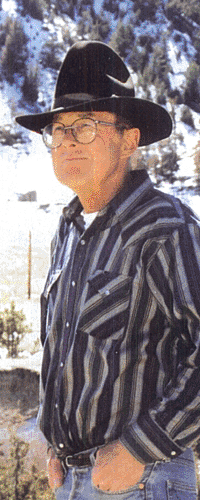
Randy
Kruger
(Photo
by Tim Findley)
"I'd never seen a
wolf up close before, and these were big animals."--RANDY
KRUGER
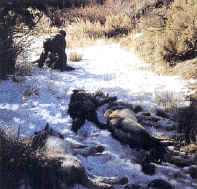
(Photos by Randy Kruger)
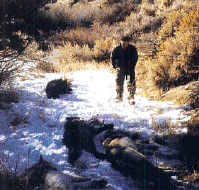
U.S. Fish & Wildlife biologist
Mike Jimenez was found with four tranquilized wolves in a ditch on the
LU's private property, next to the ranch's calving grounds. When
rancher Randy Kruger (top) drove by, Jimenez claimed he and Wes
Livingston of Hawkins & Powers aircraft charter company were
waiting for a helicopter.
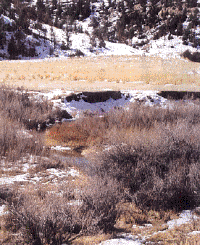
(Photos by Randy Kruger)
If the feds' helicopter had landed on
the yellow flat above and not where the power lines crossed, which is
where the two men said it came in, they would have had to drag four
wolves through Gooseberry Creek to get to the shade in the ditch. That's
about 480 pounds of tranquilized canine. Randy Kruger points to the
place he found the two men and the wolves. BEFORE: Frank
Robbins, Wyoming rancher, is having nothing but trouble with the
Worland BLM.
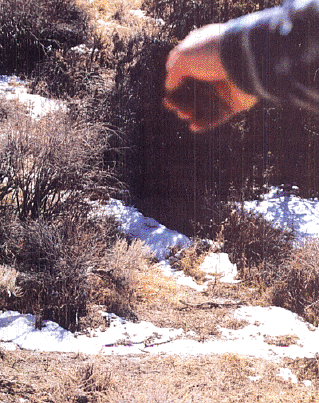
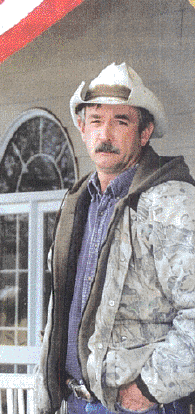
(Photo
by Tim Findley)
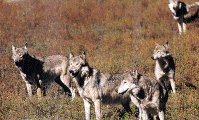
(©
Thomas Kitchin, Tom Stack & Associates)
Gray wolves in Canada,
same type of critters that were drugged and transported to Yellowstone
National Park by Bruce Babbitt in 1995. Ed Bangs, below, head of the
wolf recovery program for the Bureau of Land Management, warned from
the beginning that wolf packs could never be confined to Yellowstone
and would soon be feeding in the cattle and sheep ranches of Montana,
Idaho, and Wyoming. These vicious predators are already out of
control. Bangs now kills more wolves than he saves and wants to take
them off the endangered species list. He would just like to get back
home to Alaska.

Ed
Bangs
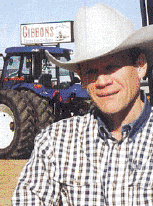
Clay
Gibbons, above, farm implement dealer, has been serving the people of
Worland, Wyo., for decades. With Park County Commissioner Jim
Morrison, below, he formed Guardians of the Range to help ranchers and
to figure out why the federal government is not living up to its own
rules.

(Photos
by Tim Findley)
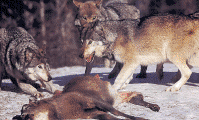
(©
Thomas Kitchin, Tom Stack & Associates)
Gray
wolves devour a white-tailed deer. They prefer slower moving cattle
and sheep, especially the young ones.
(Photo
by Tim Findley)
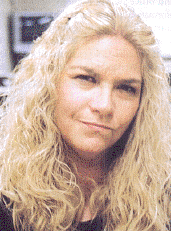
Janine
Terry, public affairs officer for the Worland BLM, refused RANGE
the right to check employee records for "cash beyond
salaries."
(Photo
by Tim Findley)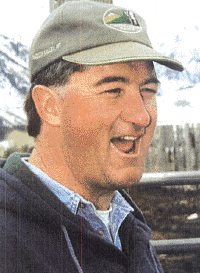
Montana
Rancher Todd Durham enjoys a light moment. He's usually not so happy
after seeing cattle decimated by wolves. His neighbor's 600-lb
yearling (below) fought for her life against a pack of wolves as shown
by her skid marks in the snow.
(Photo Courtesy of Durham
Ranch)


(Photo
Courtesy of Durham Ranch) Click
to enlarge
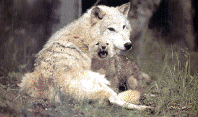
(Copyright
Doug Gaskill)
Wolves
care for their young but prey upon others, occasionally killing
members of their own pack.
Soft
as they look, they are wild and vicious.
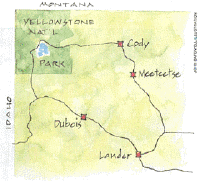
The
map shows a large area of Wyoming. How (and why) the Dubois wolves
ended up in Meeteetse, about 70 miles to the northeast and across a mountain
range, is a matter of contention. FWS has several explanations. (John
Bardwell Illustration)

Barbie,
Pete Durham's daughter-in-law
(Photos
by Tim Findley)
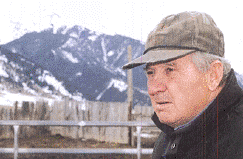
Pete
Durham (above) had never seen a wolf in Madison Valley until recently.
Now they're too close to daughter-in-law Barbie's house and children.
|



